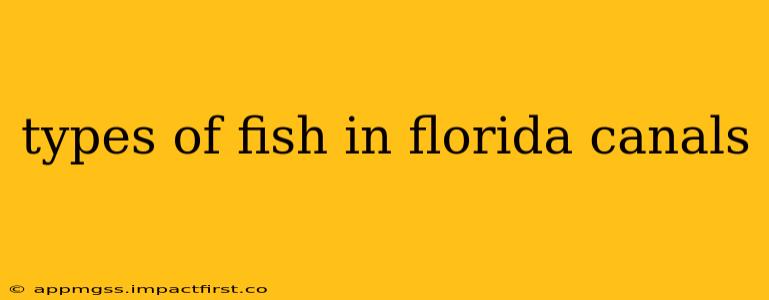Florida's extensive network of canals provides a unique and diverse habitat for a wide array of fish species. These waterways, often connecting lakes, rivers, and the ocean, offer a mix of freshwater, brackish, and saltwater environments, supporting a surprisingly rich ecosystem. This guide explores the common types of fish you might encounter in Florida canals, addressing some frequently asked questions along the way.
What types of fish live in Florida canals?
This depends heavily on the specific canal's location and connection to other water bodies. Proximity to the ocean will significantly influence the species present. However, some fish are common across many Florida canals. These include:
- Largemouth Bass: A quintessential Florida freshwater fish, largemouth bass thrive in canals with ample vegetation and cover.
- Bluegill: These panfish are prevalent throughout Florida canals, serving as a vital part of the food chain and a popular target for anglers.
- Channel Catfish: These bottom-dwelling catfish are opportunistic feeders found in many canals, particularly those with muddy bottoms and slow currents.
- Pickerel (Chain Pickerel): A predatory fish inhabiting canals with aquatic vegetation and slower moving water.
- Tilapia: While not native, tilapia are often found in Florida canals, sometimes introduced by accidental releases from aquariums or aquaculture facilities. They are quite adaptable.
In canals closer to the coast, or those with connections to brackish water systems, you're more likely to encounter species like:
- Snook: A prized game fish found in brackish and saltwater canals, often near mangrove areas.
- Redfish: Another popular game fish, inhabiting canals with access to the ocean, preferring shallow, brackish waters.
- Tarpon: These large, silvery fish are occasionally found in larger canals that connect directly to the ocean. They are highly migratory.
- Spotted Seatrout: These flavorful fish frequent brackish canals, often near seagrass beds or oyster bars.
Are there any dangerous fish in Florida canals?
While most fish found in Florida canals are harmless, it's wise to exercise caution. Some species, while not aggressive, can inflict painful stings or bites:
- Catfish: While generally docile, larger catfish can deliver a painful sting with their spines.
- Lionfish: These invasive species, though not typically found in most canals, have been sighted in some coastal areas. Their venomous spines are a serious concern.
- Stingrays: In canals with direct access to the ocean, stingrays are a possibility. Their venomous barbs can cause significant pain.
Always practice responsible fishing and handling of fish.
What kind of fish are good to eat from Florida canals?
Several fish found in Florida canals are safe and delicious to eat, but it's crucial to be aware of water quality and potential contamination. Always check local advisories regarding fish consumption before eating any catch from a Florida canal. Popular edible species include:
- Largemouth Bass: A tasty and popular game fish.
- Bluegill: Excellent panfish, delicious when pan-fried or baked.
- Channel Catfish: A firm, flavorful fish suitable for various cooking methods.
However, always remember to follow Florida's fishing regulations and size/bag limits.
Can you catch fish in Florida canals?
Absolutely! Florida canals offer excellent fishing opportunities, with varying success depending on the time of year, location, and species targeted. A Florida fishing license is generally required for angling in most canals. Remember to check the relevant regulations before you go fishing. Popular fishing techniques include using live bait, artificial lures, and jigs.
What is the best time to fish in Florida canals?
The best time to fish in Florida canals varies by species and season. Generally, early mornings and evenings are optimal for most species, as they are most active during these cooler times of day. The winter months can be slower, while spring and summer offer increased activity for many fish.
This information provides a general overview; the specific fish found in any given canal will depend on many environmental factors. Always check local fishing regulations and advisories before heading out. Remember to practice responsible angling and conservation to protect these valuable waterways and the diverse fish populations they support.
